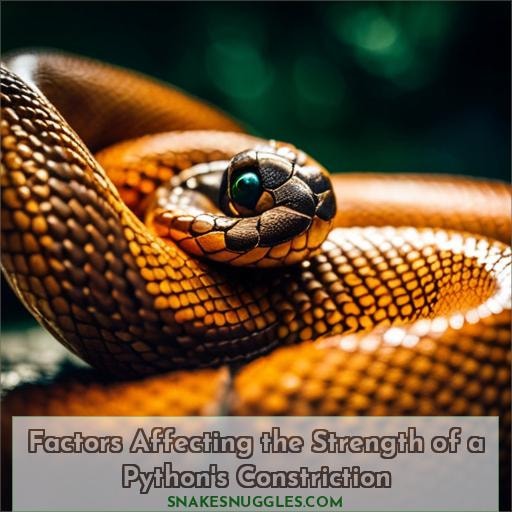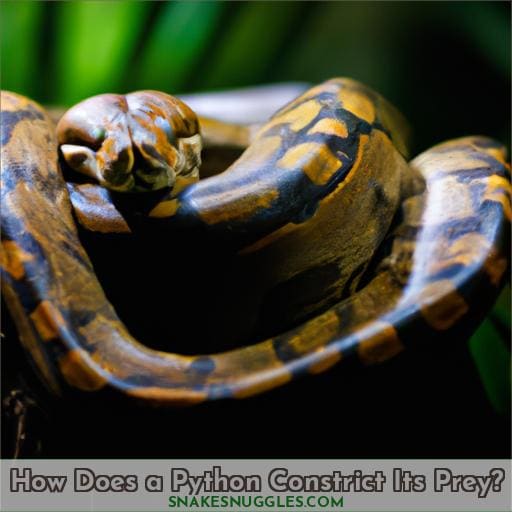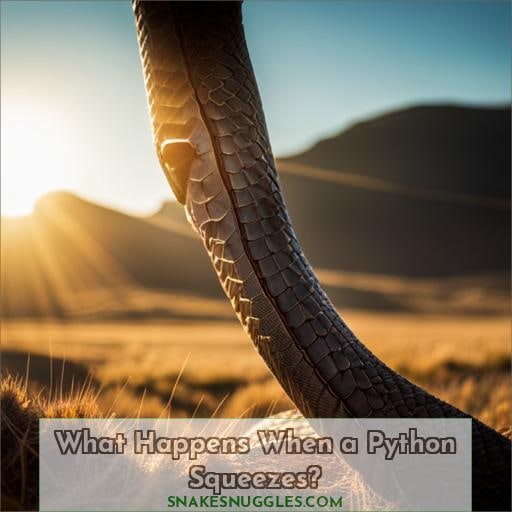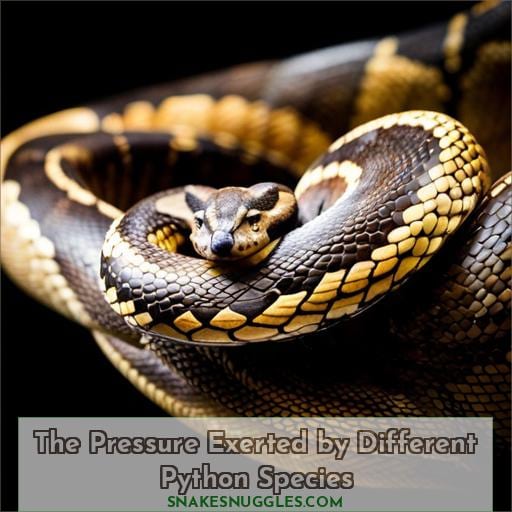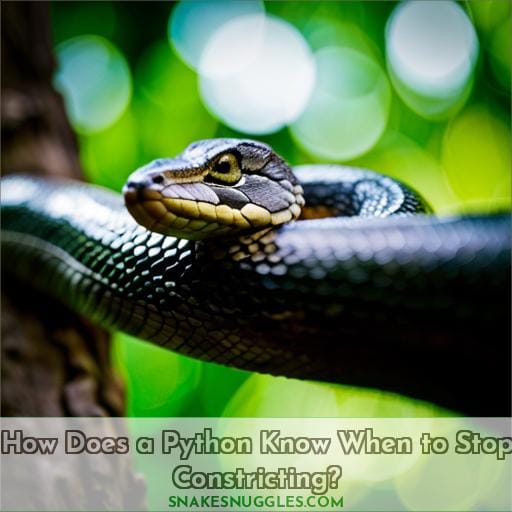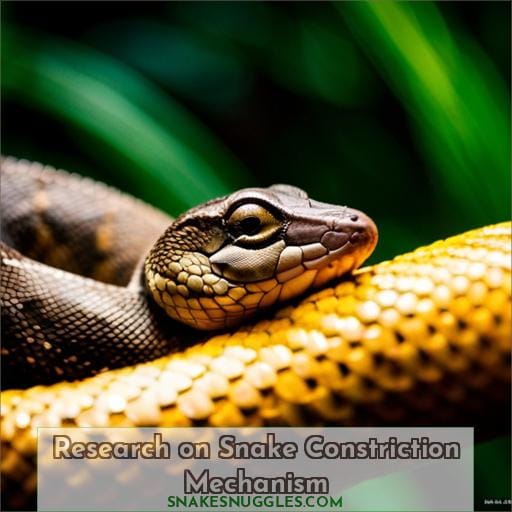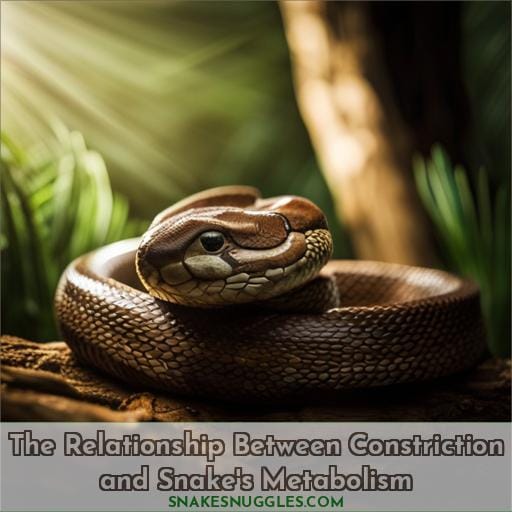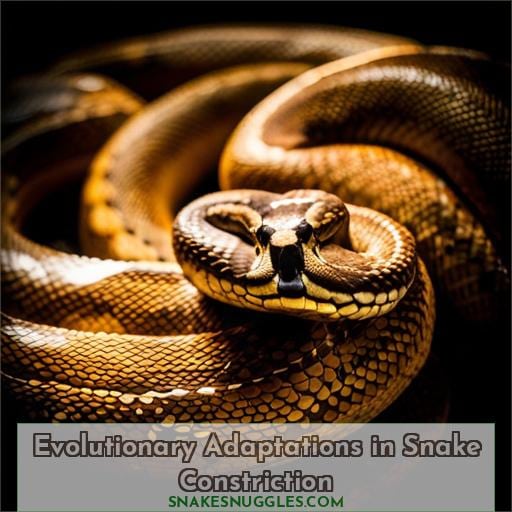This site is supported by our readers. We may earn a commission, at no cost to you, if you purchase through links.
 You may think you know how tight a python can squeeze, but the truth is far more complicated. Pythons have been squeezing their prey to death for millions of years, and they’ve evolved an impressive set of abilities that help them do it effectively.
You may think you know how tight a python can squeeze, but the truth is far more complicated. Pythons have been squeezing their prey to death for millions of years, and they’ve evolved an impressive set of abilities that help them do it effectively.
To understand just how powerful their grip can be requires looking at factors like body thickness, size of the snake, and heart rate – all elements that play into just how tight a python’s coils can become.
It’s clear there are limits to its strength. After all, if pythons could crush us with ease, then we’d be in serious trouble! But by examining research on boas from Scott Boback and other experts in snake behavior, we’ll discover exactly why these creatures are so deadly efficient when it comes to constricting.
So let’s dive deeper into this fascinating topic: How Tight Can A Python Squeeze?
Table Of Contents
- Key Takeaways
- How Tight Can a Python Squeeze?
- Factors Affecting the Strength of a Python’s Constriction
- How Does a Python Constrict Its Prey?
- What Happens When a Python Squeezes?
- The Pressure Exerted by Different Python Species
- How Does a Python Know When to Stop Constricting?
- Research on Snake Constriction Mechanism
- The Relationship Between Constriction and Snake’s Metabolism
- Evolutionary Adaptations in Snake Constriction
- The Importance of Detecting Prey’s Heartbeat for Energy Conservation
- Frequently Asked Questions (FAQs)
- Conclusion
Key Takeaways
- Python predators possess powerful constrictive abilities.
- Constriction strength depends on factors like body thickness, snake size, and prey heart rate.
- Different python species exert varying levels of constriction pressure.
- Snakes adjust constriction pressure based on prey heartbeat to optimize energy efficiency.
How Tight Can a Python Squeeze?
You can see how tightly a python coils around its prey, depending on the species and size of the snake. Reticulated pythons exert 7.8 PSI pressure, Burmese pythons 6.23 PSI, and ball pythons 4.0 PSI – making them all powerful constrictors but with different levels of squeeze power due to their individual sizes and relative strengths in comparison to other snakes like anacondas.
The strength with which a python squeezes is also directly related to its own body size as well as that of its intended victim. Larger snakes have more muscle mass and are able to generate greater force than smaller ones, even within the same species type.
Female pythons generally have stronger muscularity than their male counterparts, meaning they are able to utilize greater amounts of pressure. Transducer technology has enabled researchers to gain insight into this phenomenon by measuring constriction strength using artificial hearts attached to dead rats.
Spraying alcohol (vodka or sanitizer) into the snake’s mouth often makes them release their hold, as it disorients them enough to break away. However, if one ever finds themselves struggling against a deadly embrace, the best course of action is to unwrap the tail from the head quickly before cardiac arrest occurs.
Otherwise, there could be dire consequences. Indeed, an unimaginable scenario would be if a pet python mistakenly identifies a hand as food, leading to danger not only for the animal itself but also for the potential owner.
While these cases are rare incidents, they have been reported over the years. Nevertheless, it is still advisable to proceed with caution when handling these large, wild creatures.
Factors Affecting the Strength of a Python’s Constriction
Understanding the factors that affect a python’s ability to squeeze is key to knowing how tightly they can constrict. Body thickness, size of the python, prey size, and heart rate all play an important role in determining how strong a snake can become when squeezing its target.
Pythons are able to adjust pressure based on these variables and thus tailor their attack accordingly.
Body Thickness
The thickness of a python’s body directly correlates to the strength of its constriction, with larger pythons able to exert more powerful pressure. Reticulated pythons measure 7.8 PSI, Burmese pythons measure 6.23 PSI, and ball pythons measure 4 PSI on average when measured by force measurement systems.
Anacondas are also known for their thick bodies and can reach up to 90 PSI during constrictions. This is due partly to their greater muscle mass as well as a higher heart rate than other snakes, such as pet pythons or smaller species found in Asia, Africa, and Australia.
Artificial hearts have been used by researchers studying snake behavior, which show how boas detect prey heartbeats indirectly through coils around them before releasing. This is something they use energy conservation tactics for, compared to venomous snakes like cobras, who rely on toxins instead.
Understanding the connection between size and body thickness makes it easier to understand why some species are so successful at hunting, while also ensuring safety when handling these creatures too.
Size of the Python
Your size determines how powerfully you can coil around your prey. Pythons come in all shapes and sizes, with the most common species being reticulated pythons, Burmese pythons, and ball pythons. The pressure they exert when constricting is directly related to their body thickness.
- Reticulated python: 7.8 PSI
- Burmese python: 6.23 PSI
- Ball python: 4 PSI
Size also affects which type of prey these snakes hunt. Larger ones are capable of taking down endothermic animals, while smaller ones may struggle against ectothermic creatures like frogs or lizards. Larger snakes have a stronger defensive ability since they can squeeze harder if threatened by predators than their smaller counterparts.
Prey Size and Heart Rate
By sensing the prey’s heart rate, you can adjust constriction pressure for a successful kill. Pythons use their hydraulic system to increase and decrease psi based on the size of the prey and its heartbeat.
This method allows them to conserve energy while maximizing effectiveness as predators.
With larger animals, they must apply more force – up to 7.8 PSI with reticulated pythons. However, smaller ones require less power due to lower heart rates. In such cases, ball pythons squeeze at 4 PSI or below.
Constrictive power is also affected by gender, with females generally stronger due to the size difference from males.
Snakes are masters of the constriction technique, thanks largely in part to this skillful adaptation that helps regulate the snake’s force according.
How Does a Python Constrict Its Prey?
Pythons are powerful constrictors, capable of squeezing their prey with strong coils. They accomplish this by relying on detection to find their targets and then using constriction pressure to kill them.
They have a keen sense of heat tracking that helps them detect endothermic animals, such as mice or other small mammals. Once the python has found its target, it will ambush hunt using camouflage and size for defense.
It also takes advantage of its higher eye placement for water-skimming vision to be more successful in acquiring food sources from aquatic environments.
When it comes time to fight another snake, anacondas have heavier body thicknesses and weights on average, giving them an edge over pythons in terms of physical defenses. However, both snakes employ similar predatory behaviors. They are active at night during hunting season and rely heavily on surprise attacks through ambush hunting techniques.
They also have stealthy skimming vision capabilities that increase the chances of successfully capturing their next meal efficiently without expending too much energy. They do not chase after fast-moving prey items all day long, but instead capture them after many attempts throughout most days or weeks, depending on the circumstances.
Pet pythons can potentially mistake hands for food, leading to dangerous situations. Although rare, incidents involving pet pythons killing humans are reported every once in a while. This is more common in non-venomous species like boa constrictors. These snakes detect tiny heartbeats through coils to know when to apply just enough pressure for a hard squeeze before releasing again.
What Happens When a Python Squeezes?
When you come across a python in its natural habitat, be prepared to feel the immense power of its coils as it can apply up to 7.
Pythons are constrictor snakes that kill their prey by squeezing it with powerful coils and conserving energy by detecting the heartbeat of their victims. When compared with other species such as anacondas, pythons have weaker constriction power (6-14 PSI) but still pose a significant threat and potential danger for humans.
The evolutionary implications behind this behavior are fascinating. Studies suggest measurement technology has been able to prove how much force each species exerts when squeezing, which allows us to understand why some are stronger than others.
For instance, Green Anacondas likely have the strongest squeeze at around 90 PSI, while Reticulated Pythons reach only 7.
Moreover, research shows that certain factors affect how tight a python squeezes, such as size (larger ones having greater strength), heart rate (they adjust pressure based on the victim’s pulse), gender (females being generally stronger due to internal body dimension differences), or even temperature since endothermic animals suffer more from constricting than ectothermic ones do.
This leads scientists away from the traditional suffocation theory towards cardiac arrest instead as the main cause of death during these events in nature.
With all this said, however, there is no denying the potential dangers posed by pet pythons mistakenly mistaking human hands for food. There have been rare incidents reported where they killed people despite careful handling techniques employed trying to avert tragedy from occurring.
The Pressure Exerted by Different Python Species
When it comes to the pressure exerted by different python species, the Reticulated Python, Burmese Python, and African Rock Python are some of the strongest constrictors. They can exert an impressive amount of force with their coils – 7.8 PSI for Reticulated Pythons, 6.
23 PSI for Burmese Pythons, and 4.0 PSI for Ball Pythons, respectively – making them incredibly dangerous predators in their natural habitats as well as potential hazards when kept as pets due to mistaking hands or feet for food sources.
Reticulated Python
You can feel the powerful pressure of a reticulated python’s coils, strong enough to make an elephant shudder. Reticulated pythons typically exert 7.8 PSI of muscle strength and are one of the most powerful snakes in terms of constriction force.
Their large size gives them greater offensive capabilities against their prey type as well as higher speed than most other non-venomous or venomous species. This makes them effective ambush predators with superior heat detection skills for locating their victims quickly and accurately.
Studies on artificial hearts revealed that reticulated pythons could adjust pressure based on heart rate signals from its prey while using less energy overall due to its larger size compared to smaller python varieties like ball pythons.
This makes the reticulated python even more lethal in comparison, since it takes less time for cardiac arrest to occur under such immense force – all without breaking a sweat!
Burmese Python
The Burmese python can exert 6.23 PSI pressure when constricting, making it slightly less powerful than its Reticulated python counterpart. Its strength and size depend on the species: larger snakes have greater force due to thicker coils.
Pet pythons may mistake hands for food, so caution is necessary in an environment with venomous snakes present. Coiling triggers cardiac arrest; unwrapping tail-to-head or alcohol spray can stop constriction and save a life if needed.
African Rock Python
Experience the African Rock Python’s powerful coils as it closes in on its prey. Its heat-sensing patterns and skillful evasive tactics make it a formidable predator.
African rock pythons are among the largest snakes, capable of reaching lengths up to 20 feet and weights over 200 pounds – perfect for exerting deadly force with their constriction power. Field tests show they can squeeze 8-9 PSI, enough to crush bones and cause cardiac arrest in most animals encountered.
While much research has been done on python constriction techniques, little is known about how these reptiles detect prey or adjust their grip based on size and heart rate.
How Does a Python Know When to Stop Constricting?
Understanding how a python’s coils know when to release can be fascinating. Research has shown that snakes adjust their constrictive pressure based on prey heart rate. Pythons, like other ambush predators such as anacondas, have evolved heartbeat sensing for energy conservation and evolutionary adaptation.
- Constriction power is regulated around the size of the prey in order to induce cardiac arrest more quickly. Larger pythons squeeze harder than smaller ones due to their greater body thickness.
- Ball pythons exert an average of 4 PSI, while Burmese and Reticulated species reach up to 6-7 PSI respectively. Female pythons are generally stronger due to size differences between males and females.
- Pressure is also adjusted depending on the victims’ heart rate. If it’s too slow or too fast, they may not achieve optimal effectiveness with their attack method, so predatory selection occurs before constriction begins.
- Alcohol spray (vodka or sanitizer) near its mouth may cause it to stop squeezing, according to snake experts who suggest using this technique should you ever face a snake attack from your pet python gone rogue!
- Unwrapping tail-to-head can also make snakes stop squeezing, but only do so if you’re familiar with handling large reptiles.
These active hunters use camouflage and ambushing tactics, which makes them successful predators despite having weaker venom compared to 600 out of 3500 nonvenomous species worldwide.
Research on Snake Constriction Mechanism
Scott Boback from Dickinson College conducted a study on boa constrictors to understand their constriction mechanism. His research revealed that snakes can adjust the pressure they use for squeezing based on the prey’s heartbeat, thus confirming they know when it is time to stop.
This remarkable ability helps conserve energy and reduces the risk of vulnerability while hunting.
Scott Boback’s Study on Boas
Scott Boback’s study on boas revealed the fascinating truth about how they sense when to stop constricting, proving that knowledge truly is power. By using dead rats with artificial hearts, he was able to mimicry tactics and assess energy dynamics in different environmental factors.
The results showed that boas adjust their constriction pressure based on prey physiology and thermal tracking. Understanding how tight a python can squeeze is essential for survival! This groundbreaking biology research has shed light into the depths of scientific inquiry by providing insight into snake behavior, which could not be discovered without this type of investigation.
Through careful observation, we now know more about these powerful predators than ever before.
Snakes Adjusting Pressure Based on Prey’s Heartbeat
You can feel the power of a snake’s constriction as it adjusts pressure based on its prey’s heartbeat. Research from Dickinson College uncovered how boas sense this information to ensure an accurate time of death for their victims.
Boas detect tiny heartbeats through their coils, then relax when they stop beating. Artificial hearts showed that boas applied more pressure and constricted longer than usual, adjusting according to the strength of each pulse.
Captive snakes responded similarly, using less force with weaker heart rates to conserve energy and reduce vulnerability while hunting. Endothermic creatures like rats or mice are instinctively sensed by these predators.
Constricting demands energy, so sensing life signs provides an efficient way for apex hunters such as pythons and green anacondas to kill with precision without expending excessive amounts of effort.
The Relationship Between Constriction and Snake’s Metabolism
Surprisingly, the pressure a snake exerts to constrict its prey actually affects its own metabolism. Researchers have uncovered that snakes adjust their grip based on the heart rate and size of their prey – conserving energy in the process.
This evolutionary adaptation allows them to select appropriate targets for constriction power.
Energy conservation is key; snakes use less force when they detect weaker heartbeats or smaller-sized victims.
Artificial hearts were used by Scott Boback from Dickinson College to study snake constriction behavior, which showed boas using more pressure than normal with no heartbeat detected at all.
Constricting demands energy and raises a snake’s metabolism, yet sensing prey’s pulse saves energy while also reducing vulnerability as it confirms the time of death accurately without having to waste effort squeezing further once life has been extinguished in an animal victim.
An alternative theory suggests that this ability evolved not through detecting tiny pulses but rather vibrations felt beneath ground level instead! It is clear that pythons are capable predators, adapting over millions of years so they can hunt effectively with minimal risk – understanding how tight they squeeze adds another layer of complexity towards comprehending these fascinating creatures!
Evolutionary Adaptations in Snake Constriction
Evolution has shaped the behavior of snakes in various ways, such as their ability to constrict prey with pinpoint accuracy. Snakes are thought to have evolved from early reptiles that fed on slow-moving animals or those without a regular heartbeat.
As an adaptation, snakes developed a highly precise sense for detecting when their victims’ hearts stop beating and use this moment as confirmation of death during constriction – allowing them to release quickly and conserve energy.
Early Snakes and Prey Selection
Discover how ancient snakes used their constriction power to select the perfect prey. Venomous and non-venomous snakes alike have adapted to sense a variety of sensory cues, including body temperature and pulse rate.
This helps them determine which prey types will be most vulnerable or easy to kill with constriction.
Early snakes likely fed on slower, cold-blooded animals that were easier for them to detect and overpower using their unique adaptive capabilities. They also had an advantage in sensing pulse rates because they could feel the heartbeats through their coils as they wrapped around the victim’s body tightly before squeezing it until death occurred due to cardiac arrest, rather than suffocation from lack of air intake.
Constricting demands energy, so by being able to accurately sense when death has occurred, these primitive predators can conserve energy while still efficiently taking down a meal every time without fail!
Sensing Prey’s Heartbeat as Confirmation of Death
By sensing the prey’s heartbeat, snakes can accurately confirm death and conserve energy. They sense small pressure changes in their coils, which indicate a pulse, making constriction an evolutionary adaptation for efficiency.
Pulse sensing is more energy efficient than visual or chemical tracking. Anacondas have a clear advantage due to their larger size and greater power of squeeze. Constricting triggers cardiac arrest rather than suffocation; pythons release when they detect this type of death.
Snakes adjust pressure based on heart rate strength, conserving energy with smaller victims that die faster from lower PSI levels.
Rarely, pet pythons mistake hands for food, leading to danger as they don’t know when to stop squeezing. Alcohol spray works best here too! Evolution has enabled them with an amazing ability – one that ensures both survival and control over their environment through accurate confirmation of prey’s demise without expending unnecessary effort or resources.
The Importance of Detecting Prey’s Heartbeat for Energy Conservation
Knowing when to stop squeezing is essential for pythons, as it conserves energy and reduces vulnerability. Can you imagine how much effort would be wasted if the snake kept on constricting long after a prey had died? To achieve this feat of precision timing, pythons rely on their unique evolutionary adaptation: sensing prey’s heartbeat.
Research conducted by Dickinson College’s Scott Boback has shown that boas are able to detect tiny heartbeats through their coils. This ability helps them adjust pressure accordingly. Pressure adjustment depends heavily on the size of the animal being squeezed and its corresponding heart rate.
As such, snakes use less energy than they otherwise would have without this ability. They no longer need to guess at an appropriate level of strength or waste excess energy trying different levels until finding one that works best with a certain type of creature.
Prey detection also allows snakes to conserve even more energy by avoiding ectothermic animals altogether. This is largely because constriction does not affect these creatures enough to make any real difference in terms of food intake for large predators like pythons or anacondas.
These predators must consume vast amounts every time they eat something substantial, such as small mammals or rodents.
This ability gives reptiles yet another advantage over other predators out there. Most predators do not possess such sophisticated sensory capabilities, nor could they replicate it using simple trial-and-error methods alone.
This is due to all the variables involved with each individual hunt scenario. These variables range from size/weight ratios between predator/prey pairs to the biochemical composition making up both species’ bodies.
Frequently Asked Questions (FAQs)
Are pet pythons dangerous?
Yes, pet pythons can be dangerous. They have the potential to mistakenly identify hands as food and can even lead to fatalities in rare cases. Constriction power depends on size; larger snakes squeeze harder, and female pythons are generally stronger due to their size.
Pet owners must be aware of these risks when handling their snake for safety’s sake.
What is the difference between anacondas and pythons?
Anacondas and pythons are both large constrictor snakes, but anacondas are thicker and heavier with more powerful squeezing power. They reside in different regions: anacondas in South America, pythons in Asia, Africa, and Australia.
Anacondas can swim faster and hold their breath longer; they have higher eye placement for better water-skimming vision.
Can alcohol help a snake release its grip?
Yes, alcohol can help a snake release its grip. Spraying vodka or sanitizer into the mouth of a python may cause them to loosen their coils and stop constricting.
How does size affect a python’s constriction?
Size affects a python’s constriction; larger snakes squeeze harder due to greater body thickness. Female pythons are generally stronger, and pressure is adjusted based on prey size and heart rate. Unwrapping the snake tail-to-head can stop constriction, while spraying alcohol in the mouth may make them release their grip.
Is constriction more effective against endothermic or ectothermic animals?
Constriction is more effective against endothermic animals, such as mammals and birds, than ectotherms like reptiles and amphibians. For instance, Reticulated pythons exert 8 PSI pressure, while Burmese pythons exert
Conclusion
As the old adage goes, knowledge is power. And understanding how tight a python can squeeze is no exception. With the right knowledge, you can protect yourself and your loved ones from the potential dangers of a python’s powerful constrictions.
Pythons have the ability to adjust their constriction pressure based on the size and heart rate of their prey. Reticulated pythons exert up to 7.8 PSI of pressure, Burmese pythons exert 6.23 PSI, and ball pythons exert 4.
Research done by Scott Boback and other scientists has shown that snakes can sense their prey’s heartbeat and use it to determine when to stop constricting. This evolutionary adaptation helps conserve energy for the snake and has been key in its success as a species.
With this understanding of how tight a python can squeeze, you can now take the necessary steps to protect yourself and your loved ones.

